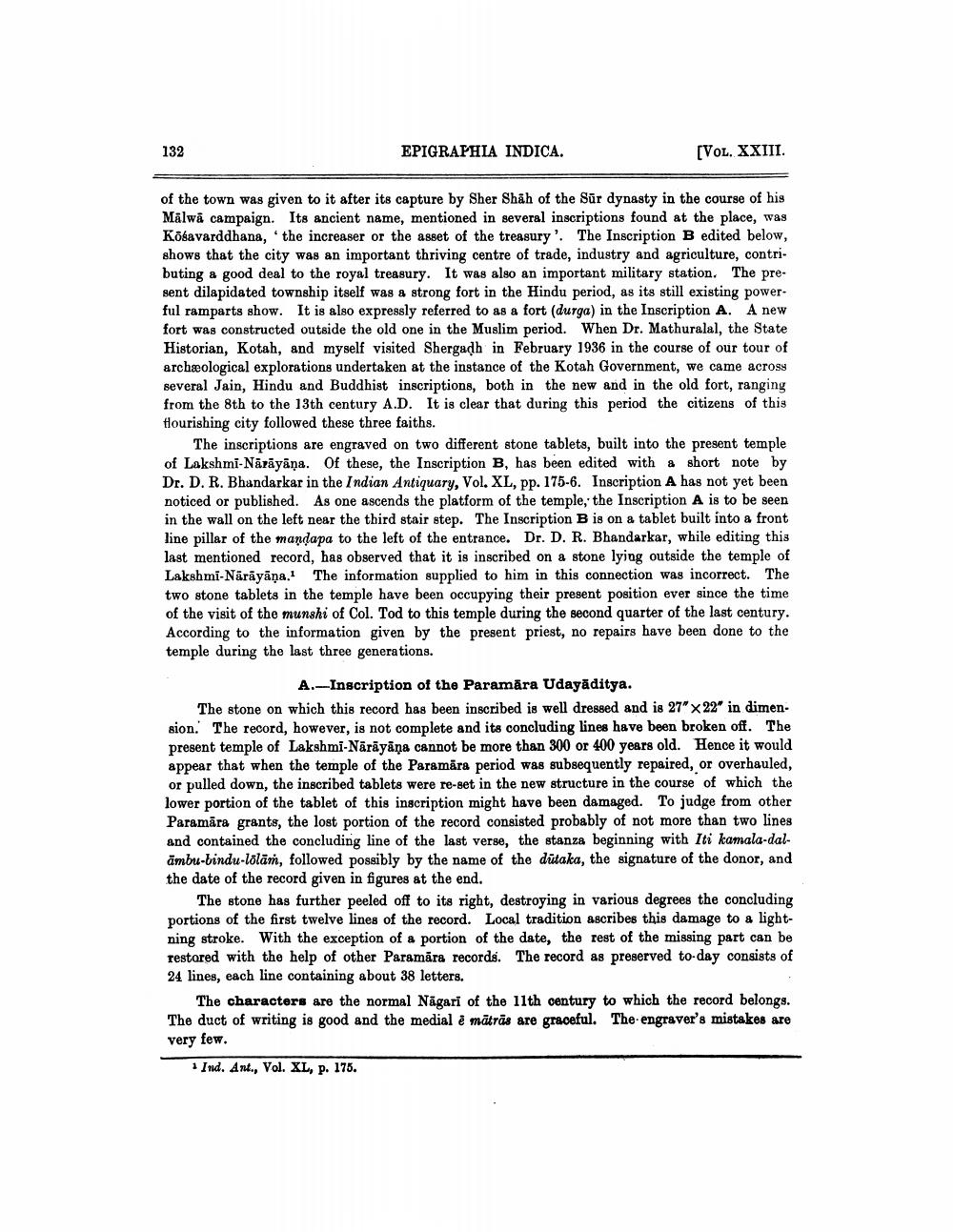________________
132
EPIGRAPHIA INDICA.
[VOL. XXIII.
of the town was given to it after its capture by Sher Shah of the Sur dynasty in the course of his Malwă campaign. Its ancient name, mentioned in several inscriptions found at the place, was Kösavarddhana, the increaser or the asset of the treasury'. The Inscription B edited below, shows that the city was an important thriving centre of trade, industry and agriculture, contributing a good deal to the royal treasury. It was also an important military station. The present dilapidated township itself was a strong fort in the Hindu period, as its still existing powerful ramparts show. It is also expressly referred to as a fort (durga) in the Inscription A. A new fort was constructed outside the old one in the Muslim period. When Dr. Mathuralal, the State Historian, Kotah, and myself visited Shergadh in February 1936 in the course of our tour of archæological explorations undertaken at the instance of the Kotah Government, we came across several Jain, Hindu and Buddhist inscriptions, both in the new and in the old fort, ranging from the 8th to the 13th century A.D. It is clear that during this period the citizens of this Hourishing city followed these three faiths.
The inscriptions are engraved on two different stone tablets, built into the present temple of Lakshmi-Nārāyāņa. Of these, the Inscription B, has been edited with a short note by Dr. D. R. Bhandarkar in the Indian Antiquary, Vol. XL, pp. 175-6. Inscription A has not yet been noticed or published. As one ascends the platform of the temple, the Inscription A is to be seen in the wall on the left near the third stair step. The Inscription B is on a tablet built into a front line pillar of the mandapa to the left of the entrance. Dr. D. R. Bhandarkar, while editing this last mentioned record, has observed that it is inscribed on a stone lying outside the temple of Lakshmi-Nārāyāņa. The information supplied to him in this connection was incorrect. The two stone tablets in the temple have been occupying their present position ever since the time of the visit of the munshi of Col. Tod to this temple during the second quarter of the last century. According to the information given by the present priest, no repairs have been done to the temple during the last three generations.
A.--Inscription of the Paramāra Udayāditya. The stone on which this record has been inscribed is well dressed and is 27" x 22" in dimension. The record, however, is not complete and its concluding lines have been broken off. The present temple of Lakshmi-Nārāyāņa cannot be more than 300 or 400 years old. Hence it would appear that when the temple of the Paramāra period was subsequently repaired, or overhauled, or pulled down, the inscribed tablets were re-set in the new structure in the course of which the lower portion of the tablet of this inscription might have been damaged. To judge from other Paramāra grants, the lost portion of the record consisted probably of not more than two lines and contained the concluding line of the last verse, the stanza beginning with Iti kamala-dalambu-bindu-lölām, followed possibly by the name of the dutaka, the signature of the donor, and the date of the record given in figures at the end.
The stone has further peeled off to its right, destroying in various degrees the concluding portions of the first twelve lines of the record. Local tradition ascribes this damage to a lightning stroke. With the exception of a portion of the date, the rest of the missing part can be restored with the help of other Paramāra records. The record as preserved to-day consists of 24 lines, each line containing about 38 letters.
The characters are the normal Nagari of the 11th century to which the record belongs. The duct of writing is good and the medial é mātrās are graceful. The engraver's mistakes are very few.
* Ind. Ant., Vol. XL, p. 175.




